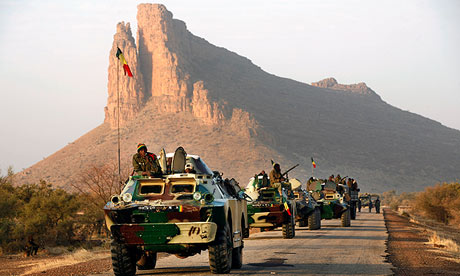Reportage del Guardian da Tessalit, città chiave per il controllo del Mali:
Tessalit assumes vital importance in Mali’s struggle against Islamist rebels
Saharan oasis town has geostrategic significance for Bamako, France and Tuareg separatists that helps explain the desert war
Afua Hirsch
Timbuktu may have attained mythical status as a fabled desert city, and its sister city Djenné may be renowned worldwide for its mosque – the largest mud building in the world – but there is a lesser-known town inMali that has also cemented itself into local folklore.
For many, Tessalit – a remote oasis set in one of the harshest stretches of Saharan landscape – is rich in history, intrigue and rumour. But now it lies at the heart of the country’s conflict.
As one Malian told me, the entire war in Mali can be explained by the battle between the Malian state, Tuareg separatists, and Algeria to wrest control of what some believe is one of the most geostrategically important locations on earth.
“There are only three points on earth with this geostrategic importance,” said Hamadoun Dicko, a tour guide in northern Mali. “Tessalit is one of them. Whoever controls Tessalit controls the Sahara.”
The desert around Tessalit, which sits on the southern end of the desolate Tanezrouft plain and west of the rocky Adrar des Ifoghas mountains, has become the last stronghold for Islamist rebels in northern Mali, pushed out of the major towns they have controlled since last March into obscure desert hideouts.
The French and their partners – including the US, which has a long history of conducting aerial surveillance in the vast expanse of the Sahara – believe that the rebels could benefit from arms caches in the region to restock and regroup.
“The mountains around Tessalit are a natural place for the rebels to hide,” said Andrew Lebovich, a Dakar-based researcher on the Sahel and north Africa. “This is an area where they have been hiding out for decades; there are caves and caches up there. It is totally impossible to know exactly what is going on there.”
Reports on Monday that Tuareg rebels of the National Movement for the Liberation of Azawad (MNLA) captured two senior Islamist insurgents fleeing towards the Algerian border – not far from Tessalit – to escape French air strikes, seemed to chime with fears that Islamists are hiding in the region.
Members of the MNLA said they had seized Mohamed Moussa Ag Mohamed, an Islamist leader who imposed harsh sharia law in the desert town of Timbuktu, and Oumeini Ould Baba Akhmed, believed to be responsible for the kidnapping of a French hostage by the Movement for Unity and Jihad in West Africa (Mujao) an al-Qaida splinter group.
“We chased an Islamist convoy close to the frontier and arrested the two men the day before yesterday,” Ibrahim Ag Assaleh, a spokesman for the MNLA, told Reuters from Ouagadougou in Burkina Faso. “They have been questioned and sent to Kidal.”
But the retreat of rebels into the desert poses a potential problem for France, which has led a military intervention intended to be a decisive swoop, purging northern Mali of the groups and then handing the country back to Malian and other African troops.
“In the cities that we are holding, we want to be quickly replaced by the African forces,” the French foreign minister, Laurent Fabius, told France Inter radio earlier today.
Asked whether the French could pull out of Timbuktu, whose liberation from Islamist hands has been one of France’s greatest victories in the war in Mali so far, Fabius replied: “Yes, it could happen very fast. We are working on it because our vocation is not to stay in the long term.”
But for many Malians it is no surprise that it is Tessalit that has become the obstacle to French hopes for a swift exit. France has a long history of involvement in the town, which has had a deeper strategic importance stretching back to pre-colonial times.
Berny Sèbe, an expert in Franco-African relations at the University of Birmingham, said: “I think Tessalit has captured the imagination because it is a very lush and prosperous oasis – the last oasis in Mali before crossing the border into Algeria.
“It was a very important oasis in colonial times – it has a lot of food, water and agriculture. From a geostrategic perspective, it played an important role in the colonial rivalry between the competing military authorities of French Algeria and French Sudan.”
The importance of Tessalit to the French led to the construction of the Amachach military garrison, 7km south of the town. Amachach was used in the 1950s as a strategic base in the fight against Algeria’s National Liberation Front, and was later equipped with sophisticated technology by the US army for the “war on terror”.
The US, which has been moving special forces in and out of Tessalit for several years, has been concerned at mounting Islamic extremism in the region. The presence of radical Islamist preachers from Pakistan and Afghanistan were first reported by locals there in 2002 and the region became an early stronghold for international jihadists in the Sahara.
But there was intelligence about radical Algerians in the region much earlier. One Malian army commander reported that locals in Tessalit observed the movements of Mokhtar Belmokhtar as far back as 1996. Belmokhtar would later earn notoriety as the Al-Qaida in the Islamic Maghreb leader behind the In Amenas hostage crisis in Algeria, in which 38 oil and gas workers were killed last month.
Fabius said that France was striking the region because the rebels “cannot stay there a long time unless they have ways to get new supplies”. France may also hope to gain access to the Tessalit airstrip, which some analysts say is the real strategic importance of the town.
“What is really important about Tessalit is that it has a very large and very good airfield,” said Lebovich. “It is the only military-quality airfield north of Gao, and it’s a better airfield than Kidal.
“It lets you get all sorts of things into that area, and if you want to stage expeditionary missions, it is better located than others in northern Mali.”


